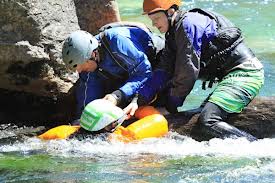Very difficult to swim victim to shore
Once you have grabbed the victim, now comes the tough part - getting the two of you to shore. If the C-Spine is OK, this is a lot like swimming with a swamped boat except the swimmer isn't as streamlined. If the C-Spine is damaged, you need to take great care to prevent further injury and paralysis. The head needs to be immobilized and you probably don't have that gear with you. The best you can typically do is ensure they are face up and breathing and wait for help from others you are paddling with - do no harm. If you have to swim, make certain others set safety below - boat and safety lines.
Fast, simple, extremely risky
A contact rescue, swimming to the victim without a safety line, may take little or no time to set-up but it also carries a great deal of risk. If the person is conscious and can move, there are so many other better alternatives that can be just as fast - remember RETHROG, this is the GO part and the last one on the list. Live swimmers can panic and unless you have some lifeguard training, both of you can end up drowning. The simple part is getting to the victim. Swimming both the victim and yourself to shore isn't so simple. Sometimes there isn't any great alternative or rescue time is very limited. A good example is an unconscious swimmer reasonably close to shore.
Contact Rescues and C-spine control
 Hopefully you will never encounter this situation on the river. Cervical spine and spinal cord injuries are quite challenging even for professional rescue personnel. A major goal is do no further harm. Once you get them safely on shore, give strong consideration to calling in the professionals. They have far better tools and training than we could possibly carry.
Hopefully you will never encounter this situation on the river. Cervical spine and spinal cord injuries are quite challenging even for professional rescue personnel. A major goal is do no further harm. Once you get them safely on shore, give strong consideration to calling in the professionals. They have far better tools and training than we could possibly carry.
Contact rescues are always a last resort. Generally there are faster and much safer alternatives. Think about how you plan to get the victim and yourself to shore once you got them. On the positive side there is no set-up time and if the victim is close enough, you should be able to reach them quickly. Contact rescues are sometimes used when the victim is unconscious and can't help themselves. They may have drowned or possibly have back, neck, or head injury. You are definitely going to need some assistance with this rescue. Work as a team and have others set safety downstream. For serious C-Spine injuries, have someone get the first aid kit and gather splinting material simultaneously. Also consider sending someone to get professional help - you are going to need it to safely evacuate the victim.
Page 2 of 2
